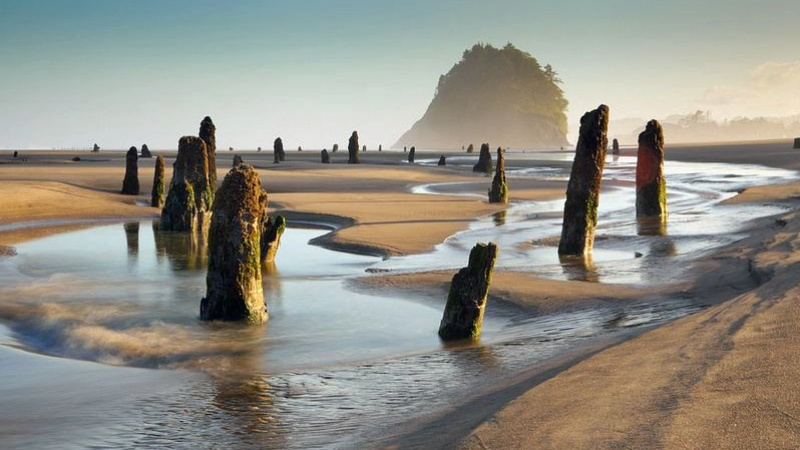 Kos (Greece), a car dragged inland for tens of metres by the wave of the small tsunami on July 20, 2017.
Kos (Greece), a car dragged inland for tens of metres by the wave of the small tsunami on July 20, 2017.  The Cape Scotch lighthouse (Aleutian Islands, Alaska) razed to the ground by the tsunami on 1 April 1946
The Cape Scotch lighthouse (Aleutian Islands, Alaska) razed to the ground by the tsunami on 1 April 1946  Neskowin (Oregon): trunks submerged by the 1700 tsunami on a beach near the Ghost Forest
Neskowin (Oregon): trunks submerged by the 1700 tsunami on a beach near the Ghost Forest © University of Oregon
Tsunami waves are very different from storm waves: when trying to understand the impact of this phenomenon, the most common mistake is to compare two very different phenomena. Unlike wind waves, tsunami waves move the entire volume of the water column from the bottom to the surface and not just the surface layers, have amplitudes of tens or hundreds of kilometres and carry a lot of energy. When it reaches the coast, the speed of the tsunami decreases compared with in the open sea, but it can still exceed 10 metres per second, almost forty kilometres per hour.
Analyses of recent events, as well as simulations in specially equipped tanks, have shown that a tsunami wave of a few tens of centimetres can drag an adult into the sea, while higher waves can easily carry entire ships for hundreds of metres inland from the affected area, as happened for example in the events of Sumatra (2004), Japan (2011).
A wave between half a metre and a metre high can unhinge doors and windows and break through heavy iron gates. Larger waves can easily break down masonry walls, tear a house from its foundations, drag along any type of material they encounter in their path.
Even the most solid buildings can be knocked down by a tsunami with particularly high waves: the waves of the Aleutian Islands tsunami on 1 April 1946 were over thirty metres high and completely destroyed three lighthouses in Cape Scotch, Alaska. Five hours later, the same waves reached Hilo, Hawaii, over three thousand kilometres away, causing at least 156 deaths.
Tsunami waves have enormous force: that is why if you feel a strong or prolonged earthquake near the coast, you must immediately evacuate the area, escaping as far and as high as possible. As the video shows, made in a testing tank equipped for this purpose, the speed of a wave of just over thirty centimetres is faster than that of a person running to escape, and just thirty centimetres of water are more than enough to throw an adult man down to the ground and to drag him away.
In addition to the immediate effects of tsunamis, linked to the kinetic energy carried by moving water, there are also long-term effects on the environment and on agriculture. After a tsunami, large quantities of sea salt tend to deposit on the ground, salt which then tends to accumulate and concentrate, killing existing plants - including trees - and preventing new ones from growing, to the point of making any cultivation impossible and thus eliminating an important source of livelihood for the affected population, adding more damage to that caused by the impact of the waves.
The phenomenon of sedimentation of deposits during tsunami ingressions is also particularly important for identifying traces of past events, for which there is no historical documentation. For example, researchers have been able to date a major tsunami which hit the coast of Japan at the beginning of the year 1700, by studying the hundreds of dead pines in the Copalis Ghost Forest in Washington State, on the northwest coast of the United States.
The trees were submerged by a flood of at least one metre caused by the tsunami going upstream along the river. By analysing the growth circles it was possible to exactly determine the year of their death, which occurred precisely because of the salt deposited in the ground: the discovery is very important as it allowed to identify the seismic source of a major tsunami which hit the eastern coasts of Japan, called "orphan tsunami" because the Japanese catalogues recorded no local earthquake which could have generated it.
The areas flooded by tsunamis also have large quantities of sediments of various kinds from the seabed, including mud, sand, stones and very frequently shells too. The analysis of the sections of these deposits, called tsunamites, allows collecting more precise data on this type of phenomena, improving the knowledge of tsunamis which occurred in history and allowing to study events occurring in ancient times, in order to understand the frequency of tsunamis and the danger of certain areas.



